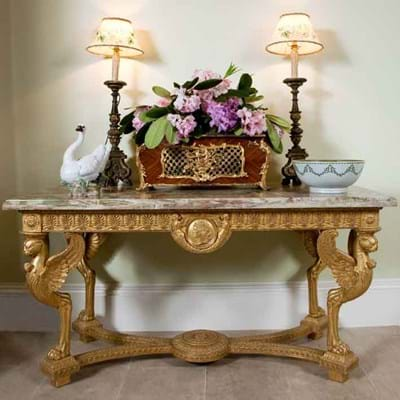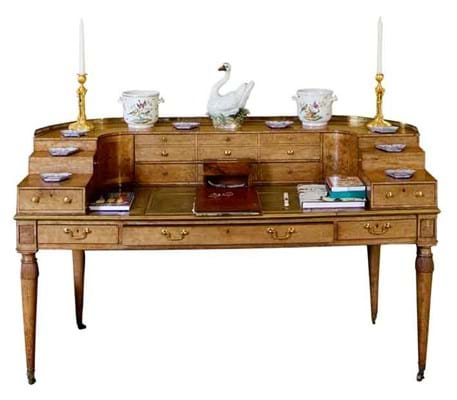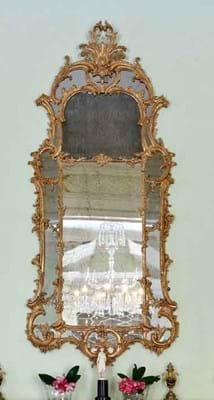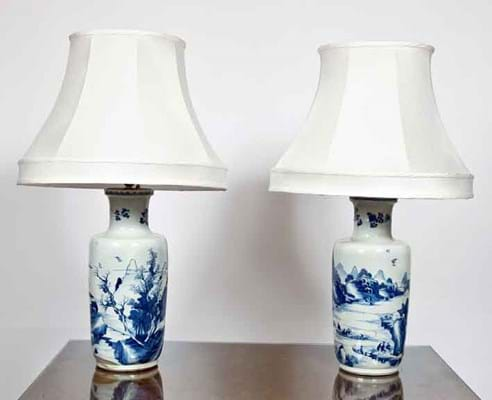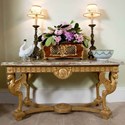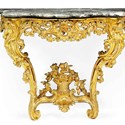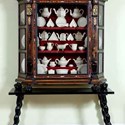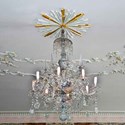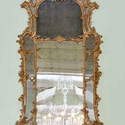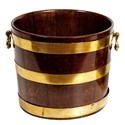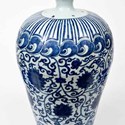Nor, one imagines, was it much of a hardship for Mealy's to agree to 'streamline' their buyer's premium to accord with Christie's 25% figure, rather than their usual 20% inclusive of tax.
Certainly the contents of the Congreve family's Georgian mansion were what the market was looking for. They ranged from the very finest - 91 lots that brought a sell-out hammer total of £2.8m at Christie's King Street on May 23 - to the typical country house mix of the rare and the routine offered on the premises on July 10-11 in a sale overseen by Mealy's.
It has been years since the last great Irish country house auction - the Abbeylix House sale by Mealy's in 1995. Although there have been fine individual 'on the premises' dispersals, such as the €3m Luggala, Co Wicklow, sale in 2006, and others consolidated at one fine venue, the country house sale seemed as close to extinction in Ireland as it has become in Britain.
This one however came along at a time of the country's worst economic crisis since the 1930s.
That said, a number of the treasures at Mount Congreve, Co Waterford, were provenanced to Christie's house sales in post-Blitz-era London - the Lionel de Rothschild sale in Kensington in April 1942 and the Viscountess Harcourt sale in Belgravia in October 1943 - so perhaps timing isn't everything provided the contents are right.
"We were confident," said George Gerard Mealy, who conducted the sale held by the Castleconner, Co Kilkenny auctioneers. "There is still money out there, even in Ireland, for items of exceptional quality. They loosened up money people have been holding onto and live internet bidding brought in the international community."
The 1100 lots in the Mealy's sale, which included everything from an €82,000 (£68,330) Carlton House desk to a €90 (£75) riding saddle, notched up €2.5m (£2.08m), with a results sheet showing some 40 five-figure hammer prices.
Country house provenance is obviously a factor among trade bidders, but 'country house fever' also applies at lower price levels.
"With close to 15,000 viewers, the sale attracted huge interest from the Waterford community, all of whom were acutely aware of the house, but few of whom had ever seen inside it," said Mr Mealy. "Hence, there was frantic bidding for lower-value items as local people battled for souvenirs from the estate."
Of the 800 lots which concern this report (the rest were books and wine) about half were sold for three-figure sums, generally comfortably above estimate. From a c.1600-20 Palermo albarello at €850 (£708) to a late-Victorian mantel clock at £340 (£280), and from a c.1815, 28-piece Chamberlain's Worcester Imari part-tea service at €950 (£790) to a 19th century walnut chest at €620 (£515) there was pretty well something for all interests.
The Congreve family had added pieces to the house since it was built around 1760, although the great love of the last family member at the house, Ambrose Congreve, who died last year aged 104, was the world-renowned gardens which, as far as the sale went, were a beautiful backdrop rather than a revenue raiser.
And although everything in the garden wasn't perfect (being instructed to sell, the auctioneers exercised their discretion in letting a number of lots go below estimate) with a 90% selling rate and a total 25% above pre-sale hopes, it was about as lovely as it gets.
Christie's may have taken the best of the silver, a £285,000 épergne by Thomas Pitts, leaving a c.1718 kettle to lead the Mealy's offering at a mid-estimate £2200, but in other areas Mount Congreve had much to offer.
The London trade dominated buying in the upper reaches, with Irish privates and some strong French and Italian competition for the Continental material not far behind.
Furniture
As at the Christie's sale, English furniture took the top price but French and Italian material was also in keen demand.
The best-seller was a 6ft (1.83m) wide Regency mahogany Carlton House desk, a classic example illustrated on these pages with that extra mark of quality - a stamped Bramah lock to the central section. Estimated at €80,000-100,000, it took €82,000 (£68,330).
From a century earlier came a pair of c.1720 carved giltwood and gilt-gesso side tables now with inset, 3ft 5in wide, 2ft deep (1.05m x 61cm) breccia marble tops. There had been restorations and replacements to the swags and frieze carvings but, against an €18,000-25,000 estimate, the tables made €46,000 (£38,330).
Lighting
Great cut-glass chandeliers, large classic pieces with inverted dish coronas and glass drops, were in strong demand despite most of them having undergone restoration and replacements.
The top-seller was the latest, largest and least restored - a late 18th or early 19th century eight-light example, 5ft high and 3ft 4in diameter (1.52 x 1.02m), which tripled lower expectations when it made £45,000 (£37,500).
Just behind, and also tripling the lower estimate, was a mid-18th century, 5ft (1.52m) high, ten-light example, which took €44,000 (£36,670), and a mid-18th century, six-light chandelier, 3ft 4in (1.02m) high, which doubled the lower estimate at €16,000 (£13,330).
Unsurprisingly the Waterford mansion had examples of the county's renowned cut glass - both of which left estimates behind. A pair of George II, five-light chandeliers, 3ft 6in (1.07m) high, one with extensive replacements, made €22,000 (£18,330). The other, a single George III example, 3ft 8in high by 2ft 4in wide (1.12m x 71cm), tripled hopes at €30,000 (£25,000) despite restoration and replacements.
Probably the most decorative lighting lot was a pair of Louis XVIII, c.1815, bronze and ormolu candelabra with classical females holding cornucopia, with three foliate cast candle branches. The 2ft 7in (78cm) high candelabra were among the pieces provenanced to the Lionel de Rothschild sale and also an example of the auctioneer's discretion coming into play.
Estimated at €10,000-15,000, they sold at €9000 (£7500).
Mirrors
Giltwood mirrors made a major contribution to the Christie's event, where one George II overmantel example sold at £260,000, but there were plenty more left at Mount Congreve to reflect market demand. A c.1760 example, with a divided arched rectangular mirror plate and mirrored borders in a 6ft 6in high, 3ft wide (1.98m x 92cm) frame carved with rockwork, C-scrolls, foliage and flowerheads, doubled the lower estimate, selling at €32,000 (£26,670).
Bringing a mid-estimate €17,000 (£14,170) was an Irish, mid-18th century mirror, 4ft 10in high by 2ft 8in wide (1.47m x 82cm), with later shaped rectangular plate and rockwork carved surround featuring ho-ho birds and fruit and floral fretwork.
A real surprise was the success of a 5ft 7in by 4ft 6in (1.74 x 1.37m) Regency giltwood and painted overmantel mirror, with inverted breakfront cornice above a frieze of putti pulling a chariot between flower-entwined column pilaster angles. Estimated at €1500-2500, it made €13,000 (£10,830).
Peat Buckets
Regarding Irish brass-bound mahogany peat buckets, it was interesting to see how examples fared on their native heath.
At Mealy's, auctioneer George Gerard Mealy said: "They are still very strong sellers. Almost every house we clear has at least one pair and they rarely go for less than €1000, even if they are more modern reproductions. Georgian period examples can often fetch between €3000-5000 for relatively plain examples of small proportions, while the exceptionally large pairs with documented provenance have been known to sell for six-figure sums."
No such luck at the Mount Congreve sale, but Mr Mealy's remarks were born out when a pair of 17½in (35cm) tall 20th century buckets took an above-estimate €2800 (£2330) and a pair of of 12in (30cm) high George III examples also went above hopes at €6200 (£5170).
Chinese Works of Art
Chinese porcelain and works of art made a major contribution to the success of the Mount Congreve sale. All 73 lots got away - many in the predicted three-figure range, but with enough high-fliers to add €315,000 (£262,500) to the sale total. Without labouring the point, Mealy's were happy to see most of the items going to China via European agents, easing the prospect of headaches some auctioneers have had in the past about payments.
The cataloguers could take credit in the way many of the top-sellers were identified as mark and period pieces but, as always, there were some real surprises.
Topping the section was a Wanli (1573-1620) blue and white meiping decorated with scrolling lotus between clouds and arcaded pattern bands. There was a faint hairline crack to the shoulder and it had been fitted for electricity, but the 18½in (47cm) vase estimated at €8000-12,000 took €50,000 (£41,670).
Provenanced to the Viscountess Harcourt London sale of 1943 was a 4ft 6in (1.37cm) tall, Yongxheng baluster and octagonal-section famille rose alcove vase and domed cover with a seated Buddhistic lion finial which took a mid-estimate €26,000 (£21,670).
A set of three Kangxi famille verte vases, with mid-18th century ormolu mounts to two, and later ormolu to the third, just cleared the lower estimate. Standing 15in (38cm) high, each hexafoil baluster-form vase was decorated with panels of red flowers between pierced scroll handles with climbing foliage flanking the hinged lids.
Estimated at €20,000-30,000, they sold at €20,250 (£16,875). "There were two bidders slowly battling it out over the phone and one was clearly under instructions to stop at €20,000," said Mr Mealy.
A few of the 18th century vases had been converted to table lamps, which 50 years ago and more - when such pieces were very much cheaper in real terms - plainly wasn't the act of vandalism it would be considered today.
How much the conversion cost in terms of value is difficult to say, but certainly not as much as estimators thought it might be. A 17½in (44m) tall pair of Kangxi blue and white tapering rouleau vases, painted with a continuous band of figures on ledges beside mountains, now adapted for electricity and offered with white fabric shades, were estimated at €5000-8000 but sold at €34,000 (£28,330).
Also Kangxi and 17½in (44m) tall, a similarly adapted blue and white baluster vase, painted with a continuous band of women, children and herons, sold at €23,500 (£19,170) against a €2000-3000 estimate.

